Pretzels
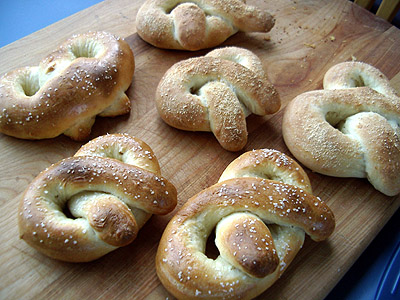 The other day I was reading Jeffrey Hamelman's recent book Bread: A Baker's Book of Techniques and Recipes when I came across his pretzel recipe. His recipe requires a pate fermente overnight, a long fermentation, and a bath in a solution of water and lye, which means rubber gloves and goggles are required.
The other day I was reading Jeffrey Hamelman's recent book Bread: A Baker's Book of Techniques and Recipes when I came across his pretzel recipe. His recipe requires a pate fermente overnight, a long fermentation, and a bath in a solution of water and lye, which means rubber gloves and goggles are required."Rubber gloves and goggles and caustic fluids to make a batch of pretzels?!? You've got to be kidding me," I thought.
The next day I found myself flipping through another baking book when I stumbled across another pretzel recipe. No caustic bath. No preferment. Not even an initial fermentation: simply mix everything together, shape the pretzels, and bake them; beginning to end, under an hour.
So which is it? Is it necessary to make the preferment and use lye to make decent pretzels at home? Do you even need to ferment the dough to make passable pretzels, or can you just jam them into the oven?
By the way, the other baking book I was looking at was Breaking Bread with Father Dominic 2. Not a bad little book. I gather that it is out of print, but if you see a cheap used copy at the local bookstore it might be worth picking up.
I didn't follow his recipe exactly, but it provided a nice balance to Hamelman's recipe.
The Experiment
There was no way I was going to try the lye bath at home. Maybe to make world class, authentic German pretzels that is necessary, but for a half dozen pretzels at home? Forget about it.
I decided to try make pretzels with an initial fermentation and without. I also tried boiling them briefly in water, egg washing them, and just baking them dry. If any of those methods could produce something reasonably like the soft pretzels I've had before I'd be happy.
The Recipe
I buy my yeast in a jar so that I can measure out as much or as little as I want (well, that and it is cheaper when you bake as often as I do). If you are using yeast from a packet, you can either use half a packet or double the recipe and use an entire packet (at least the packets they sell in the grocery stores in the US... international bakers will have to do their own conversion).
If you are using instant (AKA Rapid Rise or Bread Machine) yeast, you can just mix the yeast in with the rest of the dry ingredients before adding the warm milk and it'll activate fine. If you are using active dry yeast, mix it into the warm milk along with the malt powder (or brown sugar) and give it 5 to 10 minutes to activate before incorporating it into the dry ingredients.
PretzelsCombine all of the ingredients in a bowl and mix together until it forms a ball. I start with 2 cups of the flour and mix it together until it forms something like a thick batter, then add more flour a handful at a time until it'll form a nice ball that I can knead by hand.
Makes 6 large pretzels
1 teaspoon instant yeast
1 tablespoon malt powder or brown sugar
2-3 cups all-purpose unbleached or bread flour
1 teaspoon salt
1 cup warm milk (approximately 110 degrees, which is 1 minute in my microwave)
Either use an electric mixer to mix the dough for 5 minutes or remove it from the bowl and knead it by hand for 5 to 10 minutes until the dough begins to get smooth and satiny.
If you are going to ferment the dough (more information on whether this set is necessary below), return the ball of dough to a clean, greased bowl, cover with plastic wrap, and set it aside to rise until it has doubled in size, approximately an hour.
If you fermented it, degas the dough gently before moving on to the next step.
Before shaping, start preheating the oven to 425 degrees.
Cut the dough into 6 pieces. Roll each one into a short log, cover with a towel, and let the dough relax for 5 to 10 minutes. After it has relaxed you should be able to roll it out and stretch again fairly easily.

After taking this photo, I let them relax again and then gave each a third roll and stretch session before they were as long and thin as I wanted (about 15 inches long and about as big around as my index finger). They'll nearly double in width while baking, so it is ok to roll them out quite thin.
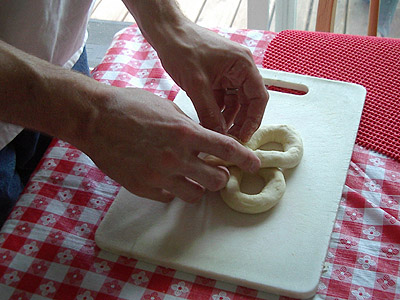
Shaping pretzels is simple, once you get a hang of it. Place a rope of dough on the work surface in front of you. Take each end in a hand, loop the dough away from you, and bring the ends back toward your stomach, crossing them about an inch above the rope. Apply a little bit of pressure to make the loops stick together, but not too much because you don't want then to flatten out.
Pretzels don't appear to need to rise again before baking, so you just need to figure out how you want to prep them for the oven. Here are the options I tried:
To boil them: If you want to boil them, bring a pot of water to a boil. Dunk each of the pretzels into the boiling water for 5 seconds, then place them onto a baking sheet and sprinkle with coarse salt (I use the kosher stuff that is easy to find at the grocery store) or other toppings.
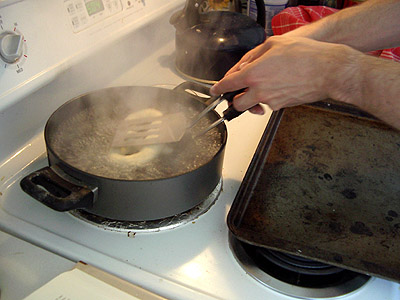
I used a pair of spatulas to hold the pretzel in place while holding it under water.
To egg-wash them: Simply place them on a baking sheet, brush them gently with an egg that has been whisked, then sprinkle with coarse salt or other toppings.
To bake them (mostly) dry: Sprinkle or spritz them with a little bit of water so that the toppings will stick, then sprinkle with coarse salt or other toppings.
Place the baking sheets into the oven. It took around 15 minutes for my pretzels to get golden and brown. Remove from the oven and eat immediately.
Results
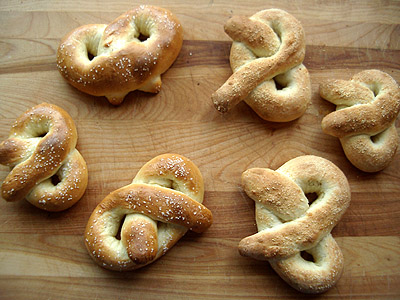
We definitely thought the boiled pretzels (on the left) were better than the pretzels that had just been spritzed with water (on the right). The spritzed ones were dry and had a slightly french bread like crust. Crust like that is good on french bread but not so good on soft pretzels.
I liked the boiled pretzels more than the egg-washed pretzels, my wife preferred the egg-washed pretzels better. The egg-washed ones rose considerably more in the oven than the boiled ones, so they were quite soft and fluffy. The boiled ones were still soft, but they were a little denser and chewier.
Truthfully, I couldn't tell the difference between the batch that I let ferment for an hour and the batch I baked immediately. If I were tasting them side by side with no toppings I probably could detect a slight difference. But at least when I eat soft pretzels they are a medium for other flavors (salt and mustard), either method produces an adequate pretzel.
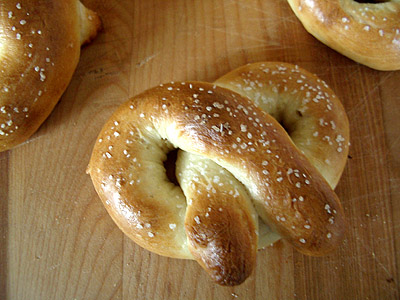
And the lye bath? At least for the home baker I can say with confidence that you can skip it.
Source: TheFreshLoaf.com

No comments:
Post a Comment